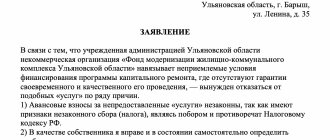The partnership is created for the purpose of jointly solving housing problems (repairs, etc.). Since it is not commercial or government, therefore funds to solve housing problems collected through contributions.
According to the laws of the Housing Code of the Russian Federation, all members of the society must pay various fees, the amount and purpose of which are discussed in advance by the members of the organization and written down in the Charter.
In case of non-payment of various deposits provided for by the Charter, its participants bear administrative responsibility and must pay a fine amounting to 0.5% of the deposit amount for each overdue day.
Find out how to register an HOA on the GIS Housing and Communal Services from our article.
Introductory
This contribution is made only once - upon joining .
It is aimed at covering the costs of the company's activities associated with creation and registration.
The entrance fee covers expenses already incurred . The contribution does not cover future costs. The initial investment does not cover the costs already incurred to improve the quality of housing.
You can download a sample application for joining a HOA, as well as a sample service agreement with the owners on our website.
Payments by SRO participants: tax accounting under a simplified system
Companies and entrepreneurs using a simplified taxation system with the object “income minus expenses” can also classify contributions to SRO as expenses. This directly follows from subclause 32.1 of clause 1 of Article 346.16 of the Tax Code.
With insurance payments, the situation is more complicated. The list of expenses that are allowed to be taken into account under the simplified tax system includes only compulsory insurance (subclause 7, clause 1, article 346.16 of the Tax Code of the Russian Federation). The question arises: is insurance mandatory when joining a self-regulatory organization? Strictly speaking, no, because the word “mandatory” is not in the name (unlike, for example, OSAGO). But in essence, if you cannot join an SRO without a policy and, as a result, you cannot engage in a certain type of activity, then insurance can be regarded as mandatory.
In practice, inspectors are likely to take a formal approach and cancel the insurance costs. At the same time, it is difficult to predict which side the court will take. Therefore, it is better for cautious taxpayers to exclude the cost of the policy from their expenses in advance.
Membership
Membership contributions cover the costs of:
- wages for temporarily hired workers (plumbers, electricians, etc.);
- remuneration of member employees;
- remuneration of governing bodies;
- remuneration of members of the audit commission;
Read our article about how the chairman’s salary is determined.
The entity to which the ownership of residential/non-residential premises located in the complex of the company's premises has been transferred becomes a member of the HOA from the moment it receives ownership of the premises. Membership fees are collected from a new member of the organization immediately after his entry .
Membership contributions are the main source of income for the organization, but their size should be insignificant compared to other contributions to ensure regular payment.
Read about the responsibilities of the HOA manager in our article.
Judicial practice in cases of collection of membership fees
Membership fees are one of the main sources of formation of property of owner organizations, and their late payment often leads to legal disputes between these organizations and their members. This article provides an analysis of judicial practice in this category of cases, and also examines the most common arguments of the parties in debt collection proceedings.
1. Legal regulation
Membership fee is money periodically contributed by a member of the owners’ organization for purposes related to the activities of the owners’ organization, including remuneration of employees, remuneration of board members, members of the audit commission (clause 60 of article 1 of the Housing Code).
The charter of the organization of owners specifies, among other things, the composition and procedure for making entrance, membership and target fees (paragraph 7, paragraph 2, article 164 of the Housing Code).
Establishing the size, composition and procedure for making all types of contributions falls within the exclusive competence of the general meeting of members of the owners’ organization (paragraph 4, paragraph 1, article 167 of the Housing Code).
The organization of owners has the right to establish in the prescribed manner the amount of contributions, and the association of owners also the amount of mandatory payments (paragraph 7, paragraph 1, article 177 of the Housing Code).
A member of an organization of owners is obliged to promptly and in full make entrance, membership and target fees and other payments provided for by law (paragraph 5, paragraph 4, article 179 of the Housing Code).
For additional financing of work and activities related to the management and operation of the common property of a joint household, members of the owners’ organization pay membership and target fees (clause 1 of Article 183 of the Housing Code).
Contributions by members of the owners' organization are made within the time limits established by the charter and the decision of the general meeting (meeting of authorized) members of the owners' organization (clause 2 of Article 183 of the Housing Code).
Disagreements on issues of making contributions are considered by the board of the owners' organization, the general meeting (meeting of authorized) members of the owners' organization, and in case of failure to reach agreement on these issues - by the court (clause 6 of Article 183 of the Housing Code).
2. Judicial practice
Typical arguments that debtors give as objections to a claim for the collection of membership fees are real or imaginary shortcomings made in determining the amount of these fees, legal registration in the minutes of the general meeting (meeting of authorized representatives) and issuing amounts for payment. Let's look at some of these arguments with a specific example.
Example 1
TS filed a lawsuit against S. to collect arrears of membership fees. In support of the claims, the plaintiff indicated that by decision of the general meeting of members of the CU, an annual estimate of income and expenses was approved, which indicated the amount of the membership fee and its calculation.
S. objected to the claim on the following grounds:
1) the calculation of the membership fee given in the estimate is incorrect. Consequently, the membership fee cannot be recovered in the specified amount;
2) by decision of the general meeting, the estimate of income and expenses for a specific calendar year was approved, after the end of which the membership fee was not payable;
3) in violation of the requirements of the law, the amount of the membership fee was indicated by the plaintiff in notices of payment of housing and communal services. An agreement for the provision of these services was not concluded, and therefore the demand for their collection is illegal.
The TS claim was satisfied for the following reasons. The court found that there was indeed an arithmetical error in the calculation of the contribution. At the same time, the amount of the contribution is the final decision of the general meeting, and its calculation is the justification. Due to the fact that the general meeting, which has exclusive competence to establish mandatory payments, agreed on the final amount of the contribution, an error made in its calculation does not affect the legitimacy of the decision.
The estimate of income and expenses was approved for the calendar year, but it does not indicate a specific validity period for the amount of membership fees. In this regard, the defendant’s argument that after the expiration of the year these contributions are not payable was found unfounded.
The court also noted that the obligation to pay membership fees exists regardless of what is shown in the notices. Accordingly, the unlawful indication of their size in the “additional services” column does not prevent the claim from being satisfied.
The appellate court left the court's decision unchanged, and S.'s appeal was not satisfied.
Despite the fact that in the case under consideration the court took the side of the plaintiff, we note that the question of the time period during which the amount of the membership fee established in the estimate for a specific calendar year is in effect is an estimate. In this regard, when indicating the amount of the membership fee in the estimate of income and expenses (which is a common practice), it is advisable to stipulate that the decision in this part is valid indefinitely (either until the fee is canceled or a new amount is established).
When considering this category of cases, defendants often refer to the failure to include information about the size, composition and procedure for paying membership fees in the CU charter. These cases are especially typical for partnerships that have not brought their charters into compliance with the current edition.
Example 2
The CU filed a lawsuit to collect arrears of membership fees, the amount and terms of payment of which were approved by the decision of the general meeting.
Objecting to the claim, the defendant indicated that the amount, composition and procedure for making membership fees should be specified in the charter. This fact follows from paragraph. 7 clause 3 art. 209 of the Housing Code (as amended on November 13, 2017), which was in force at the time of the decision of the general meeting, and in the charter of the Customs Union itself. If appropriate changes have not been made to the charter, then the decision is not legally binding and not enforceable.
The court satisfied the stated requirements, indicating that the presence or absence in the charter of information about the amount, composition and procedure for making contributions is not a basis for releasing the defendant from the obligation to pay them. According to paragraph 5 of Art. 166 of the Housing Code, the decision of the general meeting (meeting of authorized) members of the owners’ organization, adopted in the prescribed manner, is mandatory for all members of the owners’ organization. Accordingly, this decision is an independent legal fact, the legal force of which is not related to the compliance with any additional formalities. In this case, the obligation to pay the contribution arises not from the moment of amendments to the charter, but from the moment the decision of the general meeting is made.
As an addition, we note that the LC (as amended on November 13, 2017) provided for the mandatory indication in the charter of the amount, composition and procedure for making contributions (paragraph 7, paragraph 3, article 209), and the LC in the current edition - only the composition and order their introduction (paragraph 7, paragraph 2, article 164). Thus, at present, the amount of membership fees is not subject to mandatory indication in the CU charter.
The above cases have described common arguments in defense of a claim. At the same time, as a means of defense, defendants often resort to filing a counterclaim to invalidate the decision of the general meeting (meeting of authorized representatives) to establish the membership fee. Unable to challenge the very fact of introducing the contribution and its size, since this issue falls within the exclusive competence of these management bodies, the debtors base their position on procedural violations when making decisions. As a consequence, the dispute over the collection of membership fees is actually transformed into a scrupulous analysis of the procedure for convening and holding a general meeting (meeting of authorized representatives).
Example 3
TS filed a lawsuit to collect from 12 co-defendants arrears of membership fees, the amount and terms of payment of which were established by a decision of the general meeting held through a written survey.
The co-defendants filed a counterclaim to invalidate the decision of the general meeting due to its holding with numerous procedural violations, namely:
— violation of the procedure for convening a general meeting;
— incompetence of the general meeting due to lack of quorum;
— violation of the procedure for sending voting ballots to CU members;
— the presence of contradictions in the content of the agenda of the general meeting and voting ballots;
— violation of the procedure for counting votes, etc.
The court granted the counterclaim based on the following:
1) violation of the procedure for initiating a general meeting (the CU board did not make a decision to convene it, which contradicts paragraph 6 of Article 166 of the Housing Code);
2) violation of the procedure for making decisions (contrary to the requirements of paragraph 2 of Article 166 of the Housing Code, the results were counted based on the number of participants in the meeting, and not the number of votes they owned).
Taking into account the satisfaction of the counterclaim to invalidate the decision of the general meeting at which the amount and deadline for payment of membership fees were established, the court refused to satisfy the initial claim for the recovery of these fees.
Thus, as a result of the invalidation of the decision of the general meeting, the CU lost the legal basis for collecting membership fees for several calendar years, which poses a real threat to the financial well-being of the CU. The court ruling also led to other negative consequences for the CU: due to the satisfaction of the counterclaim, the decision of the general meeting was declared invalid not only in terms of establishing the membership fee, but in full (including current issues of the maintenance and operation of common property, amendments and additions to the charter, etc. .).
Conclusions:
1) when establishing membership fees, it is necessary to pay close attention to proper compliance with the laws regarding the convening, holding of a general meeting (meeting of authorized representatives) and recording its results;
2) failure to comply with these norms often entails the risk of satisfying the debtors’ claims to invalidate the decision of the general meeting (meeting of authorized representatives), which is fraught with the loss of legal grounds for collecting membership fees;
3) the absence in the CU charter of information on the amount, composition and timing of payment of membership fees does not affect the obligation established by the general meeting (meeting of authorized representatives) for their timely payment.
Target
Targeted fees are not regular because they do not cover the organization’s expenses for ongoing needs. The obligation to pay (and the amount) of the target contribution arises if it is necessary to carry out any repair work on the premises in particular or the complex of premises in general.
The size of the target contribution is determined in proportion to the share in the common property belonging to each member of the company , based on the total amount of costs, taking into account the organization’s income and state subsidies.
Targeted contributions cover the costs of:
- maintenance of common areas;
- acquisition of new public equipment;
- current repairs of common areas;
- major renovation of common areas;
Targeted contributions do not cover the costs of restoration of the premises or the entire complex as a whole.
Find out on our website how to complain about the work of the partnership or leave it.
How to reflect contributions in accounting
Annual contributions must be included in the operating expenses of the period for which they are paid. Thus, monthly contributions should be attributed to the costs of the corresponding month, and quarterly contributions – to the costs of the corresponding quarter. If regular payments are transferred once a year, then it is better to distribute them by quarters or months. The distribution method can be any: equal shares, proportional to revenue, etc. The entrance fee and the contribution to the compensation fund are one-time payments; they are transferred when joining an SRO, and the money is not returned upon departure. These amounts were traditionally accounted for in account 97 “Deferred expenses”. True, due to the amendments made to clause 65 of the Accounting Regulations*, the use of this account has recently raised many questions. But in one of its recent letters, the Russian Ministry of Finance dispelled doubts and said that there were no fundamental innovations. In particular, any expenses that do not entail the emergence of assets can be taken into account as RBP (letter dated January 12, 2012 No. 07-02-06/5). This conclusion fully applies to one-time contributions to a self-regulatory organization.
When reflecting future expenses, it is necessary to establish the period during which they will be written off as current expenses. Since the certificate of entry into the SRO is issued for an indefinite period, the company itself must approve the write-off period. It usually ranges from three to five years. The moment when entry fees can be shown in accounting is the date of receipt of the certificate.
It turns out that in tax and accounting, contributions to SROs are written off differently: in tax accounting immediately, and in accounting - over a certain period. This results in a taxable temporary difference and a deferred tax liability (DTL).
Example
In January 2012, the construction company joined a self-regulatory organization and paid a one-time fee of 90,000 rubles, as well as a contribution to the compensation fund in the amount of 350,000 rubles. The director issued an order according to which these contributions will be written off as expenses in equal parts over three years (3 years x 12 months = 36 months). The certificate of entry into the SRO was received in January 2012.
Starting in January, the company began making monthly regular contributions in the amount of 6,000 rubles.
In January 2012, the accountant made the following entries: DEBIT 76 CREDIT 51 - 440,000 rubles. (90,000 + 350,000) – money was transferred to the SRO; DEBIT 97 CREDIT 76 – 440,000 rub. – the entrance fee and contribution to the compensation fund are reflected as deferred expenses; DEBIT 68 CREDIT 77 – 88,000 rub. (RUB 440,000 x 20%) – IT is reflected.
Every month from January 2012 to December 2014 inclusive, the accountant made entries: DEBIT 76 CREDIT 51 - 6,000 rubles. – the monthly contribution to the SRO is transferred; DEBIT 26 CREDIT 76 – 6,000 rub. – the regular monthly contribution is written off for current expenses; DEBIT 26 CREDIT 97 – 12,222.22 rub. (RUB 440,000: 36 months) – deferred expenses are partially written off as current expenses; DEBIT 77 CREDIT 68 – RUB 2,444.44. (RUB 12,222.22 x 20%) – IT has been reduced.
We add that according to paragraph 5 of PBU 10/99 “Expenses of the organization”, regular and one-time contributions are considered expenses for ordinary activities. In the cash flow statement, they are indicated in the “Cash flows from current operations” section in line with code 4129 “Other payments”.
How does the type of SRO expenses affect their tax accounting?
The procedure for recognizing SRO expenses in tax accounting depends on their type.
Insurance
Insurance premiums are mandatory for each member of the organization, are distributed evenly among the members of the organization and amount to:
- 22% – Pension Fund;
- 2.9% – Social Insurance Fund;
- 5.1% – Federal Compulsory Medical Insurance Fund.
The regularity of monetary collections is described in the Charter. Typically, the insurance contribution is collected every quarter.
You can learn about how to keep accounting records on the ONS from our article. A sample estimate of income and expenses of an organization is available.
Civil relations
According to Part 6 of Art. 55.6 of the Town Planning Code of the Russian Federation, in order to obtain a certificate of admission to a certain type or types of work that affect the safety of capital construction projects, you must become a member of the SRO.
A certificate of admission to a specific type or types of work that affect the safety of capital construction projects is issued no later than three working days after the date of the relevant decision, payment of the entrance fee and contribution to the SRO compensation fund.
In addition, members of the SRO are required to pay annual membership fees (clause 3, part 2, article 55.7 of the Civil Code of the Russian Federation).
A certificate of admission to a specific type or types of work that affects the safety of capital construction projects is issued by an SRO without limiting the period and territory of its validity (Part 9 of Article 55.8 of the Civil Code of the Russian Federation).
Additional
According to the Housing Code of the Russian Federation, additional fees are charged once if losses of the organization are detected. If the financial situation of the company is again unprofitable, members of the organization again make additional contributions.
Additional investments by members of the organization are made only after the entire financial reserve has been used . After resolving financial difficulties, it is necessary to restore the reserve fund as soon as possible.
The amount of the additional fee depends on the amount required to cover losses and on the method of distribution of the entire amount of losses between the participants in accordance with the Charter:
- the same for all members;
- proportional to the size of the premises owned;
- other criteria (specified in the Charter).
Read our article about the procedure for making utility payments.
Accounting for entry fees and other payments
When joining an SRO, a construction organization pays an entrance fee, a contribution to the compensation fund and regular membership fees.
For auditors - individuals
Contributions For auditors - members of SRO AAS Payment deadline is March 31 For new entrants Paid upon joining
| Annual membership fee for regions | RUR 2,400 | RUR 2,400 |
| Annual membership fee for Moscow, Mosk. region, St. Petersburg | 3,000 rub. | 3,000 rub. |
| Contribution to the compensation fund (one-time) | — | 3,000 rub. |
The first membership fee upon joining the SRO AAS is paid by the auditor in the following order:
- upon joining in the first half of a calendar year - for the entire current year in the amount of the annual membership fee rate.
- upon joining in the second half of the calendar year - in the amount of ½ the annual membership fee.
For individual auditors - individual entrepreneurs
Contributions For auditors - members of SRO AAS Payment deadline is March 31 For new entrants Paid upon joining
| Annual membership fee for regions | 5,000 rub. | 5,000 rub. |
| Annual membership fee for Moscow, Mosk. region, St. Petersburg | 8,000 rub. | 8,000 rub. |
| Contribution to the compensation fund (one-time). | — | 3,000 rub. |
The first membership fee upon joining the SRO AAS is paid by the individual auditor in the following order:
- upon joining in the first half of a calendar year - for the entire current year in the amount of the annual membership fee rate.
- upon joining in the second half of the calendar year - in the amount of ½ the annual membership fee.
Wiring used
When debiting payments monthly, these entries are used:
- DT76 KT51. Receipt of payment to SRO.
- DT97 KT76. Attribution of contributions to expenses of the following periods.
- DT20 KT97. Systematic write-off of contributions.
When writing off contributions at a time, these transactions are relevant:
- DT76 KT51. Payment of contributions.
- DT20 KT76. Write-off of payments.
Be sure to take into account that transactions will vary depending on the type of payment.
Is it possible to return it when leaving the organization?
Monetary contributions from members of the organization are not returned, even if the person leaves the Partnership.
After a person leaves the organization, the obligation to pay various fees is removed, but previously made contributions (including the initial one) are not returned .
You can find out about changes in the Federal Law on Homeowners' Associations, as well as in what cases inspections are carried out by regulatory authorities on our website.
Compensation fund for ensuring contractual relations
A self-regulatory organization in the construction industry may create a fund to ensure contractual obligations if at least 30 members of the self-regulatory organization advocate for the creation of such a fund. This provision is provided for by the Urban Planning Code of a self-regulatory organization. To do this, members of the SRO must submit a statement of desire to participate in the conclusion of construction contracts using competitive contracting methods. This sets a minimum contribution for each member wishing to participate in the Compensation Fund.
We, the “Unified SRO Center”, will help you become a member of a self-regulatory organization with the existing Compensation Fund for ensuring contractual relations, collect a full package of documents and help you obtain permits for turnkey work.
What determines the amount of the contribution paid?
The key factor that determines how much a company must pay when joining a self-regulatory organization is the so-called level of responsibility of the work. It is directly determined by two criteria:
- what type of work is planned to be performed (calculations are different for construction and design);
- What is the cost of the work being performed?
In total, the legislation identifies five digital ranges in which the cost of work can be, and this is what determines the level of responsibility to the SRO: the table for each type of work demonstrates this dependence.
Contributions for construction work
The Town Planning Code of the Russian Federation (Article 55.16, paragraph 12) distributes the levels of responsibility relevant for construction in the SRO 2021 - the table below displays the amounts clearly.
| Level of responsibility | Cost of work under the contract in rubles | Minimum contribution for compensation of harm in rubles | Minimum contribution to secure obligations in rubles |
| First | up to 60 million | 100 000 | 200 thousand |
| Second | up to 500 million | 500 thousand | 2.5 million |
| Third | up to 3 billion | 1.5 million | 4.5 million |
| Fourth | up to 10 billion | 2 million | 7 million |
| Fifth | 10 billion and above | 5 million | 25 million |
As you can see, everything is quite logical: the more expensive a construction order a company carries out, the larger the amount it must contribute to the fund. By planning your activities in advance, you can calculate the level of responsibility to the SRO of builders using the table.
Income from business activities
To achieve its statutory goals, the HOA is allowed to conduct business activities.
Thus, an HOA can carry out the following types of activities:
- renting out part of the common property (for example, basements, attics, walls for advertising signs);
- maintenance, operation and repair of real estate in an apartment building;
- construction of additional premises and common property of an apartment building.
The HOA must spend the profit received from the listed types of business activities for the purposes specified in the charter, or for the purposes specified in the decision of the general meeting of the HOA members.
This is stated in Article 152 of the Housing Code of the Russian Federation.
What is targeted funding?
Targeted financing (TF) is the receipt of funds from the state for certain purposes. The main feature of this event is that the money received must be used strictly for its stated purpose. Strict reporting is required. It is also necessary to prepare and approve an estimate. Funding is allocated to the following projects:
- Maintenance of institutions for child and youth development.
- Cultural and educational events.
- Personnel training.
- Research activities.
- Capital investments.
- Construction of residential buildings.
- Elimination of losses.
Typically, the government allocates money to public projects. Funds are allocated for a specific purpose.
How to take into account funds for targeted financing when calculating income tax ?
Briefly about the reserve fund
Residents have the most questions about the reserve fund. It would seem that if part of the needs are covered by a targeted contribution, and there are also membership payments, why save money for anything else? However, it is impossible to do without such security; it is from this that the HOA management takes funds to eliminate the consequences:
- emergency situations;
- failures of utility networks in common areas;
- errors of service workers.
The reserve fund also covers penalties arising as a result of an unexpected jump in tariffs for electricity, gas supply and similar services.
The amount of payments to the reserve fund is determined individually in each HOA, but does not exceed 5-10% of the total monthly expenses. Such a distribution is sufficient to promptly solve problems that arise, as well as compensate for the effects of inflation. If the HOA management had to take part of the reserve fund, residents must restore its original size through contributions.
According to Art. 145 clause 2, part 5 of the Housing Code of the Russian Federation, the procedure and situations in which it is possible to use funds from the reserve fund are determined at a general meeting of homeowners. Only in case of an emergency, in conditions of time shortage, management will be able to give an order to connect the fund without convening a meeting of homeowners.
The reserve fund is replenished by:
- Contributions from HOA members.
- Charitable contributions.
- Government subsidies.
- Income from rental of unoccupied premises.
- Funds received as a result of reducing planned expenses.
The reserve fund funds are kept in a separate bank account, this allows you to control expenses and protects you from accidental expenses caused by mistake.
With proper management, the reserve fund does not need to be replenished for a long time from the funds of homeowners. However, in the event of a sharp decrease in the saved amount, it is necessary to quickly restore its amount, which under certain circumstances is possible only through an additional contribution established by the meeting.
What happens if you don't pay your HOA dues?
There are situations when citizens cannot or completely refuse to make HOA payments. But such actions lead to the following consequences:
- litigation;
- increasing the amount of debt;
- partial or complete restriction of the supply of utilities.
The level of liability will be determined based on the amount of debt.
If a citizen is not a member of the HOA, he is obliged to pay for all communications used in the house. The amount of such payments is specified in the agreement with the HOA. If a resident of the house evades such a financial obligation, he will face the same penalties as a member of the HOA.










